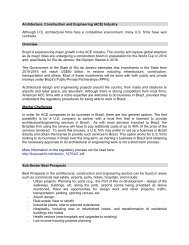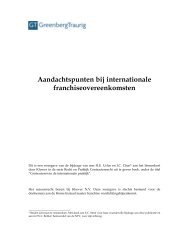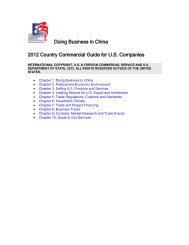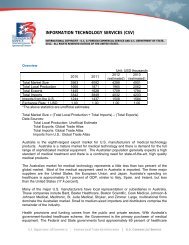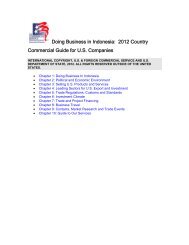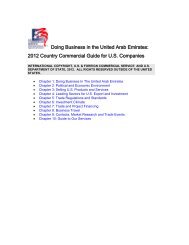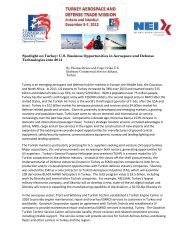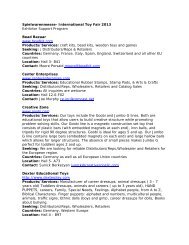CHINA: Franchising Industry - Export.gov
CHINA: Franchising Industry - Export.gov
CHINA: Franchising Industry - Export.gov
Create successful ePaper yourself
Turn your PDF publications into a flip-book with our unique Google optimized e-Paper software.
US Commercial Service – The JLJ Group<br />
China <strong>Franchising</strong> <strong>Industry</strong><br />
Page 20 of 23<br />
CONSIDERATIONS FOR US COMPANIES AND CONCLUSIONS<br />
Key Considerations Return to Top<br />
Key opportunities. The previous sections highlighted the key opportunities for US companies in the<br />
four sectors. In general, middle to high-end positioning and high quality products are increasingly in<br />
demand. This is driven by the growth of the middle class 27 . The middle class currently constitute 5% of<br />
households, but are expected to increase to 45% of all households by 2020. This presents significant<br />
long term potential, and is part of the reason why some foreign companies that use the franchising<br />
model overseas choose to invest in direct-owned outlets in China, as the potential revenue generated<br />
by direct-ownership of stores is higher.<br />
Chinese companies may lack management skills and suffer from a lack of consistency across stores. In<br />
addition, investment in R&D and product development is generally low. US companies possess the<br />
experience, skill, and know-how for establishing smooth-running outlets, and such consistent branding<br />
is key to success.<br />
Key challenges. Although there is a market for the products/services of foreign franchisors, there are<br />
still significant challenges in adopting the franchising model, as highlighted below:<br />
1. Finding good partners - In many Tier 2 cities, there are generally only a small handful of potential<br />
partners that fit the profile for what many foreign companies are looking for in JV partners. Potential<br />
partners usually have capital, but they need to be convinced of the potential of the foreign brand,<br />
and its track record in other countries and in China. Generally, potential partners prefer brands with<br />
a good international track record (especially in Asia).<br />
2. Managing franchisees – It is generally difficult to find and manage franchisees, especially in Tier 2<br />
cities. Although franchising fees are generally not the issue, start-up costs can be prohibitive due to<br />
high rents. Many local franchisees do not follow franchise standards, and sacrifice brand image for<br />
short-term profits. Thus comprehensive contractual arrangements are necessary, including those<br />
that look out for the franchisee’s interests (satisfied franchisees are more likely to abide by the<br />
rules). More time and effort needs to be put into providing training support.<br />
3. Staffing – At store level, the talent market for store managers is very competitive, and it is even<br />
more pronounced in Tier 2 cities. Direct-owned chains, like Starbucks or Haagen-Dazs, have direct<br />
control over recruitment and retention, generally offer higher salaries for store managers, and are<br />
able to devote more resources into training. Most local staff in Tier 2 or 3 cities also need rigorous<br />
training, as they have relatively limited exposure to Western chains and service concepts. Directowned<br />
chains regularly transfer store managers from Tier 1 cities to manage new store openings in<br />
Tier 2 or 3 cities and to train local staff, whereas this may not be feasible for franchised chains.<br />
4. Localization – Differences between US and other countries always mandates a certain amount of<br />
localization in international expansion. In addition to major differences between the US and China,<br />
there are also regional differences within China. It is therefore important to thoroughly analyze<br />
potential markets and to never assume success in one region will guarantee success in another.<br />
5. IPR issues – While China’s IP laws are on par with international standards, they suffer from a lack<br />
of enforcement. The responsibility to track down businesses that infringe on IP rights often falls on<br />
the IP owner. Companies should register all trademarks, brand names (both English and Chinese),<br />
URLs, and patents before entering the market.<br />
Market Access Return to Top<br />
Market entry options. There are two main options available for foreign franchisors looking to enter the<br />
Chinese market: 1. Engage in cross-border franchising. 2. Establishing a Foreign-Invested Enterprise<br />
(FIE) such as a JV or WOFE, as shown in the following chart.<br />
27 Defined by the National Bureau of Statistics as households with annual income of $7,230 to $60,240





